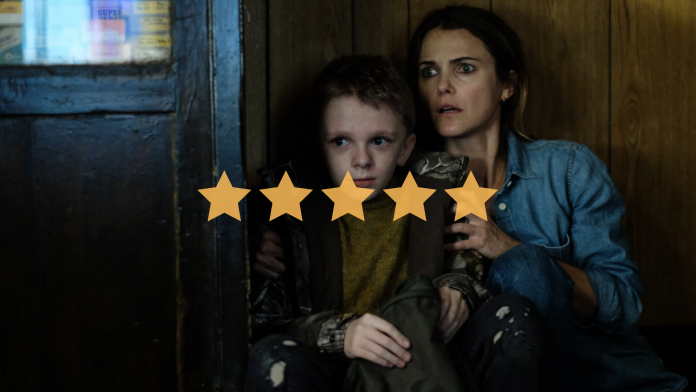Have you noticed the influx in tarot readings lately? Dipped your toe in manifesting? Encountered “Witch-tok”? The mythical, mystical, and otherwise occult is hip again, and there’s a certain sub-genre revival in scary movies to match. It’s called folk horror, and Scott Cooper and Guillermo del Toro’s latest addition to the genre is a terrifying and timely warning about the evils of climate collapse.
★★★★★
Halloween might be over, but the scares are far from done; and they’re taking a new direction. Maybe it’s the apocalyptic plague we’re having, or the devastating environmental disasters, but the modern world is now too frightening to be fun; and horror is returning to more traditional roots. Think recent hits such as Midsommar, The Witch, The Ritual, Gretel and Handsel, or the dark and twisted fairytale of Guillermo del Toro’s fantastic Pans Labyrinth. It’s a sub-genre the Mexican director is well versed in; and his production duties this time around sees Antlers becoming a new gem in the folk horror collection.
Set in modern day Oregon, within a hollowed out mining town that is a potent reminder that the environment has been ravaged, and frequent shots of junkyards and decimated forests make sure we don’t miss this point. Julia Meadows (Keri Russell) returns home there to teach. She moves in with her brother Paul (Jesse Plemons), but they both struggle with their dark family history and the dire state of the desolate town since the mine closures. When Julia’s student Lucas (Jeremy T Thomas) starts showing signs of abuse, she intervenes; but things are worse at home than she could have possibly imagined. As the mysterious death count rises, it’s up to Julia and Paul to uncover the mystery of the monstrous wendigo and protect Lucas.
Many folk horrors feature beasties from ancient mythology, and often they emerge in defence of the environment. They are tied to it, as a symbol of a people’s traditional way of life and forgotten respect for nature. They emerge to seek their revenge when we disrespect it. The star of Antlers, the wendigo, is no exception. The wendigo is a monstrous creature from Native American folklore. In its original form it was a terrifying giant with a heart of ice and a foul stench, a malevolent spirit that possessed human beings and drove them to cannibalism. The wendigo is the epitome of gluttony. No matter how many lives it devours, it is never satisfied. It is a cautionary tale, a warning against selfishness, and a symbol of a terrifying hunger so ravenous it eats up a man’s very soul; greed. In fact, some First Nations communities even list destruction of the environment among the symptoms of “Wendigo psychosis”. So it isn’t surprising that the wendigo is a relevant metaphor in popular imagination today.
We have become the wendigo. That’s the clear message of Antlers, although it doesn’t labour the point. It’s too busy having fun – and it’s all the better for it. The performances are incredible, especially from child star Thomas. The production and cinematography is slick, the characters are well written and complex, and the cheap scares are underwritten with the kind of tangible teeth-gnawing dread that follows you all the way home. The terrifying presence of the wendigo is rivalled and then outstripped by more frightening threats in the community. Among all the child abuse, addiction, domestic violence, and good old fashioned abject poverty, the audience can’t escape the feeling that somehow, we have deserved this evil. The wendigo is our reckoning, and the combined fear of the creature and of mankind itself gives Antlers a truly disturbing atmosphere. And yet, from all this, our protagonists offer up a consistent selflessness which burns like a light in the darkness.
It isn’t perfect, and sometimes the writing lands a bit on the nose. Take the painfully clichéd tropes of the disturbing-children’s-drawings-that-hint-at-the-demon, and the character who says something goofy like “the wendigo/yeti/ghost/loch ness monster? But that’s just a children’s story!”. But if we’re honest with ourselves, those well-worn clichés are part of why we love the horror genre. Could the relationships have been fleshed out more? Sure. Maybe the themes should have been investigated in more detail too. But social horror has become so de jour now that audiences sometimes expect a Ted Talk from a scary movie—and horror doesn’t have to be complicated to be important. After all, the film is based on a folk tale. And what are folk tales but simple cautionary sketches designed to scare us into behaving? Children are meant to understand them. (Although I wouldn’t show this to your kids!).
The Verdict
Antlers is thrilling, slick, clever, and properly scary; and the influence of native folklore lends it a primal, urgent edge that remains relevant to a modern audience. Cooper’s serious tone and del Toro’s charm combine in harmony, combining to make this a very special film. Watch this space; the folk-horror revival is far from over.
Words by Eli Dolliver
Antlers is in cinemas now.
Support The Indiependent
We’re trying to raise £200 a month to help cover our operational costs. This includes our ‘Writer of the Month’ awards, where we recognise the amazing work produced by our contributor team. If you’ve enjoyed reading our site, we’d really appreciate it if you could donate to The Indiependent. Whether you can give £1 or £10, you’d be making a huge difference to our small team.
